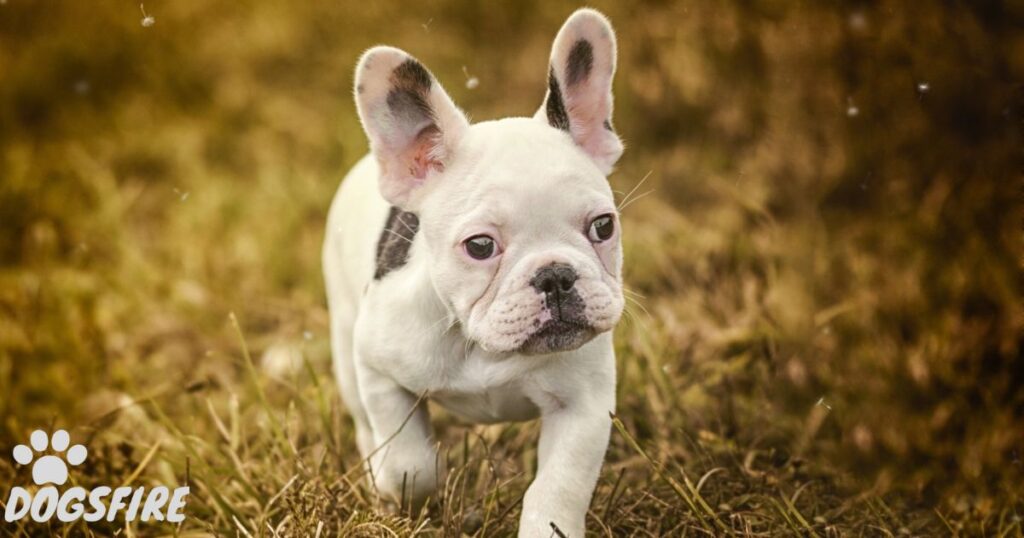French Bulldogs stop growing when they reach their full size, usually around 9-12 months of age. At this point, they reach their adult height and weight, and their growth plate’s close, indicating the end of their physical development.
Have you ever wondered when French Bulldogs stop growing? Imagine the excitement of watching your furry friend grow, reaching their full size around 9-12 months. Let’s uncover the magical moment when their tiny paws stop growing, and they become the adorable, compact companions we adore.
We know French Bulldog typically stop growing between 9 to 12 months of age. At this point, they reach their adult size, and their physical development concludes. It’s a fascinating phase in their lives as they transition from energetic puppies to the charming, compact companions they are known to be.
French Bulldog Puppy Growth Chart

A French Bulldog Puppy Growth Chart is a helpful tool to track the adorable journey of these pint-sized companions. As these little bundles of joy embark on their early stages of life, the growth chart allows you to monitor their height, weight, and developmental milestones. It provides a roadmap for their physical progress, ensuring they are thriving and growing as expected. With each passing week, the chart becomes a visual celebration of your French Bulldog’s evolution from a tiny pup to a charming and full-grown companion.
| Age (Months) | Average Weight (lbs) | Average Height (inches) |
| 2 | 3-5 | 4-6 |
| 4 | 8-12 | 8-10 |
| 6 | 12-16 | 10-12 |
| 8 | 16-20 | 12-14 |
| 10 | 20-24 | 14-16 |
| 12 | 24-28 | 16-18 |
Sure, here’s a simple representation of a French Bulldog Puppy Growth Chart:
Factors Affecting Growth

Several factors play a crucial role in determining the growth of an individual, whether it’s a human or a pet. Genetics, or the traits inherited from parents, significantly influence growth patterns. Nutrition also plays a vital role, as a balanced and nourishing diet provides the necessary nutrients for proper development.
Additionally, environmental factors, such as access to healthcare and living conditions, can impact growth. Regular exercise and physical activity contribute to healthy growth by promoting strong muscles and bones. Overall, a combination of genetics, nutrition, environment, and lifestyle choices collectively influences the growth of an individual.
Several factors influence an individual’s growth:
- Genetics
- The primary factor influencing growth is genetics. Inherited traits from parents determine an individual’s potential for growth, including height, weight, and overall physical development.
- Nutrition Adequate
- Nutrition is crucial for proper growth. A well-balanced diet provides the essential nutrients needed for bone development, muscle growth, and overall health. Poor nutrition can stunt growth and lead to developmental issues.
- Environmental Factors
- The environment also plays a role in growth. Access to healthcare, living conditions, and overall well-being contribute to an individual’s ability to reach their full growth potential. A supportive and healthy environment fosters optimal growth outcomes.
Growth Phases of French Bulldogs

Puppyhood (0-12 months)
During the initial months, French Bulldogs experience rapid growth. They go from tiny, fragile puppies to sturdy adolescents. Proper nutrition is crucial during this phase to support healthy bone and muscle development.
Adolescence (1-2 years)
In this phase, French Bulldogs continue to grow, but at a slower rate compared to puppyhood. Their bodies mature, and they reach their adult height and weight. It’s essential to monitor their diet, as overfeeding during this period can lead to weight-related issues.
Adulthood (2 years and beyond)
By the age of two, French Bulldogs typically reach their full size. Their growth plates close, signaling the end of major physical development. Maintaining a balanced diet, regular exercise, and routine veterinary check-ups become key factors in ensuring their overall health and well-being throughout adulthood.
Estimating Adult Size
Estimating adult size is a common curiosity, especially when it comes to pets like dogs. While genetics largely determine the final size, observing growth patterns during puppyhood can provide insights. Veterinarians often use factors like current weight, breed characteristics, and growth rate to make educated estimates. Keep in mind that individual variations exist, and the estimated size is not an exact prediction. Regular veterinary check-ups and discussions with breed experts can help refine these estimates, ensuring a better understanding of the potential adult size of your pet.
Growth Rate
Growth rate refers to the speed at which an organism, such as a human, animal, or plant, increases in size or develops over a specific period. It is often measured by the amount of weight or height gained during a set timeframe. In the context of children or animals, growth rate is crucial for assessing overall health and development. Factors like genetics, nutrition, and environmental conditions play significant roles in determining the growth rate of individuals. Monitoring growth rate is especially important during key developmental stages to ensure proper maturation and well-being.
Big Dogs Equal Big Litters Puppies
The idea that big dogs equal big litters of puppies is a common belief. In many cases, larger dog breeds do tend to have larger litters compared to smaller breeds. However, it’s essential to note that individual variations and factors such as genetics, health, and the age of the dog can influence litter size. While size can play a role, it’s not the sole determinant, and responsible breeding practices and proper care during pregnancy are crucial for the well-being of both the mother and her puppies.
Small Puppies the Mother’s Health
The health of small puppies is closely tied to the mother’s health. A mother dog’s well-being during pregnancy and nursing directly affects the development and vitality of her puppies. Adequate nutrition, proper veterinary care, and a safe environment contribute to a healthy pregnancy. Ensuring the mother receives the right nutrients supports the growth of strong and robust puppies. Regular veterinary check-ups, vaccinations, and attention to the mother’s overall health are crucial for the well-being of both the mother and her small puppies.
Litter Size Problems

Litter size problems can arise in various ways during the birth and care of puppies. Smaller-than-expected litters may occur due to factors such as the mother’s age, health, or breeding history. On the other hand, larger litters can present challenges, as the mother may struggle to care for a large number of puppies adequately.
Issues like inadequate milk production or the need for supplemental feeding may arise. Responsible breeding practices, proper prenatal care for the mother, and close monitoring during the postnatal period can help address and prevent potential litter size problems, ensuring the health and well-being of both the mother and her puppies.
Predicting Litter Size
Predicting litter size in dogs involves several factors, but it’s not an exact science. Breed characteristics, the age and health of the mother, and genetics play significant roles. Larger dog breeds generally tend to have larger litters, but individual variations are common. Consultation with a veterinarian, especially during pregnancy, can provide insights into potential litter size based on factors like ultrasound exams and the mother’s health. While predictions can be made, it’s important to be prepared for variations, as the actual litter size can still vary, and unexpected factors may influence the outcome.
FAQ, S
What is a healthy weight for a French Bulldog?
A healthy weight for a French Bulldog is typically between 16 to 28 pounds. Monitoring their diet and exercise helps maintain their well-being. Avoid overfeeding to prevent obesity and related health issues. Regular vet check-ups can ensure your Frenchie stays at a healthy weight.
How much should a French Bulldog weight in KG?
A healthy adult French Bulldog typically weighs between 8 to 14 kilograms.
What age is a Frenchie full grown?
French Bulldogs are usually fully grown by the age of one. They reach their adult size and weight around 12 months. After this point, their growth tends to stabilize.
How much does a 3 year old French Bulldog weight?
At three years old, a French Bulldog usually weighs between 16 and 28 pounds. Their weight can vary based on factors like genetics and individual health. Regular vet check-ups help ensure they maintain a healthy weight.
Conclusion
An individual’s growth is a complex interplay of genetic, nutritional, and environmental factors. Genetics sets the foundation for one’s potential growth, determining the upper limits that can be achieved. However, the realization of this potential depends heavily on the second crucial factor: nutrition. A balanced and nourishing diet provides the necessary building blocks for the body’s growth, influencing everything from bone development to overall physical health. Lastly, the environment in which an individual lives completes the trifecta of growth determinants. Access to healthcare, living conditions, and overall well-being all contribute to either fostering or hindering optimal growth. Recognizing and addressing these factors collectively is essential for promoting healthy development and ensuring individuals reach their full growth potential.












